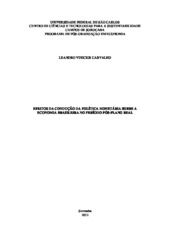| dc.contributor.author | Carvalho, Leandro Vinícios | |
| dc.date.accessioned | 2016-06-02T19:33:09Z | |
| dc.date.available | 2012-12-12 | |
| dc.date.available | 2016-06-02T19:33:09Z | |
| dc.date.issued | 2012-03-30 | |
| dc.identifier.citation | CARVALHO, Leandro Vinícios. Effects of the Conduct of Monetary Policy on the Brazilian Economy in Post-Real Plan.. 2012. 115 f. Dissertação (Mestrado em Economia) - Universidade Federal de São Carlos, Sorocaba, 2012. | por |
| dc.identifier.uri | https://repositorio.ufscar.br/handle/ufscar/2154 | |
| dc.description.abstract | This paper aimed to analyze the dynamics of the evolution of interest rates in Brazil from the period after the Real Plan. It will take place throughout the dissertation a study on the adoption and operation of the system of inflation targets, as well as the functioning and organization of the National Financial System. It will be discoursed on the implementation of monetary policy by the Central Bank and also a study made of the main theoretical discussions regarding the adoption of monetary policy regime of inflation targeting. In addition, there will be an explanation of some studies that investigated empirically the effects of monetary policy on economic variables after the adoption of inflation targeting. To evaluate the effects of maintaining interest rates at high levels will be estimated using the methodology of the Vector Error Correction, the model of monetary transmission specified by Bogdanski et al. (2000), where you can analyze the behavior of variables such as income (output gap), the exchange rate, inflation and risk premium, compared to the nominal interest rate (Selic). The estimated unrestricted model (variation of the model proposed by Bogdanski et al. (2000)) showed evidence that the Selic rate, the output gap and inflation are related as expected in the target system, the basic interest rate uses the level of economic growth (gap) as an indicator of the growing economy in order to maintain stable price levels. There was also the conclusion that there is room for reduction in interest rates between the years 2012 and 2013, albeit sparingly, to levels lower than current (between 9.0% and 10%) in order to generate a stimulus to the growth of domestic investment, since they do not commit to maintaining inflation at low levels and controlled. | eng |
| dc.description.sponsorship | Financiadora de Estudos e Projetos | |
| dc.format | application/pdf | por |
| dc.language | por | por |
| dc.publisher | Universidade Federal de São Carlos | por |
| dc.rights | Acesso Aberto | por |
| dc.subject | política monetária | por |
| dc.subject | inflação - Brasil | por |
| dc.subject | taxa de juros | por |
| dc.subject | inflation target | eng |
| dc.subject | selic | eng |
| dc.subject | monetary transmission | eng |
| dc.title | Efeitos da condução da política monetária na economia brasileira
pós-Plano Real | por |
| dc.title.alternative | Effects of the Conduct of Monetary Policy on the Brazilian Economy in Post-Real Plan. | eng |
| dc.type | Dissertação | por |
| dc.contributor.advisor1 | Figueiredo, Adelson Martins | |
| dc.contributor.advisor1Lattes | http://lattes.cnpq.br/2582161065438214 | por |
| dc.contributor.referee1 | Cruz Júnior, José César | |
| dc.contributor.referee1Lattes | http://lattes.cnpq.br/0086426315229286 | por |
| dc.description.resumo | Neste trabalho propõe-se analisar a dinâmica da evolução da taxa de juros no Brasil, no período posterior a implementação do Plano Real. Será realizado ao longo da dissertação um estudo sobre a adoção e operacionalização do regime de metas de inflação, bem como, do funcionamento e organização do Sistema Financeiro Nacional. Será discorrido sobre a execução da política monetária pelo Banco Central e também um estudo das principais discussões teóricas feitas acerca da adoção da política monetária no regime de metas de inflação. Além disso, será realizada uma explanação sobre alguns trabalhos que buscaram avaliar empiricamente os efeitos da política monetária sobre as variáveis econômicas após a adoção do regime de metas. Para avaliar os efeitos da manutenção das taxas de juros em patamares elevados será estimado por meio da metodologia do Vetor de Correção de Erros, o modelo de transmissão monetária especificado por Bogdanski et al. (2000), em que é possível analisar o comportamento das variáveis como a renda (hiato do produto), a taxa de câmbio, a inflação e o prêmio de risco, frente à taxa nominal de juros (Selic). O modelo irrestrito estimado (variação do modelo proposto por Bogdanski et al. (2000)) mostrou evidências de que a taxa Selic, o hiato do produto e a inflação se relacionam como se espera no regime de metas, ou seja, a taxa de juros básica usa o nível de crescimento da economia (hiato) como um indicador do aquecimento da economia com o intuito de manter estáveis os níveis de preços. Chegou-se também a conclusão de que há espaço para redução da taxa de juros entre os anos de 2012 e 2013, embora de maneira parcimoniosa, a patamares menores do que os atuais (entre 9,0% e 10%) com o intuito de gerar um estímulo ao crescimento do investimento doméstico, desde que não se comprometa a manutenção da inflação em níveis baixos e controlados. | por |
| dc.publisher.country | BR | por |
| dc.publisher.initials | UFSCar | por |
| dc.publisher.program | Programa de Pós-Graduação em Economia - PPGEc-So | por |
| dc.subject.cnpq | CIENCIAS SOCIAIS APLICADAS::ECONOMIA::ECONOMIA MONETARIA E FISCAL | por |
| dc.contributor.authorlattes | http://buscatextual.cnpq.br/buscatextual/visualizacv.do?id=K4481290Y6 | por |
